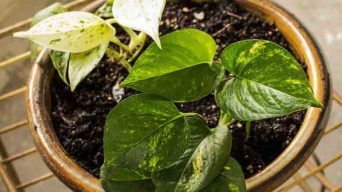Pothos root rot is a common issue caused by overwatering, where the roots of the plant begin to break down and rot, leading to wilting and yellowing leaves. To fix this, remove the plant from its pot and prune off any dead or dying roots. Avoid overwatering and ensure proper drainage to prevent further damage.
Pothos plants are popular choices for houseplants thanks to their hardy nature – they can withstand a multitude of growing conditions, making them relatively easy to take care of.
But even the toughest pothos plant won’t survive root rot if left unchecked!
If you suspect your beloved Devil’s Ivy has been affected by this severe condition, understanding what root rot is and how it impacts pothoas plants could be key in saving your greenery.
What is Root Rot?
Root rot is an insidious disease that can affect your pothos plant, causing its roots to brown and wilt if left untreated.
While it can be caused by several different fungi like Fusarium or Pythium, root rot often occurs due to overwatering which creates the ideal conditions for these fungus species to thrive on dead or dying tissue from your plants’ roots.
Prevention of this devastating disease calls for a careful balance in watering – too much will encourage fungus growth but so will not enough water!
What Causes Root Rot?
Pothos plants are a beautiful addition to any home, however they can be sensitive and susceptible to root rot.
Knowing what causes this problem is the best way of ensuring your plant stays healthy!
Overwatering
When it comes to pothos plants, more water does not always mean better!
If you overwater your pothos plant and keep the soil too wet for too long, root rot can set in – depriving thirsty roots of oxygen they need to stay healthy.
The secret is knowing when is just right: wait until that top inch of soil feels dry before giving your beloved greenery a sip or two.
A little bit less could help save them from an untimely death by overwatering – so stick with light sips instead of full gorges when caring for these resilient fauna!
Poor Drainage
For your pothos plant to reach its full potential, it’s important that the soil you use is well-draining.
To prevent water from simply pooling in the pot and rotting out roots, mix perlite or sand into a quality potting soil for better drainage.
And don’t forget to make sure there are holes at the bottom of your pots; this will allow excess moisture to escape quickly so that root rot can be avoided all together!
Root Damage
Root damage is a common issue that can leave your pothos plant vulnerable to root rot.
During repotting, it’s important to be careful not to harm the roots as they are especially susceptible after getting damaged.
To ensure you don’t cause any accidental injury, use a sharp knife and cut away dead or infected areas before proceeding with transferring them into another pot!
Fungal Infections
Fungal infections can be an unwelcome cause of root rot in pothos plants.
These fungi, like Fusarium and Pythium, love the wet environment provided by overwatering; so make sure to only water your plant when that top inch of soil is dry!
Furthermore, ensure you have drainage holes at the bottom of your pot to allow any additional moisture a way out – this will help keep those pesky fungal spores away!
Fungus Gnats
Fungus gnats may be small, but they can still cause big problems for your plants!
These dark-flying pests are usually found near houseplants in damp and humid spots.
Though harmless to humans themselves, fungus gnats carry a bacterial infection known as pythium that could lead to root rot in the plant’s soil – so it’s important to take measures against them.
To prevent their arrival and keep your pothos safe from damage, make sure its pot has drainage holes; this will let excess water out of the container while letting air flow freely around the environment where it is placed.
What Does Pothos Root Rot Look Like?
If you think your beloved Pothos plant might be suffering from root rot, then look closely for signs that often indicate this problem. These include:
Wilting Leaves
Wilting leaves may be a sign of something serious.
If your precious pothos is beginning to look droopy, it could point towards root rot – an issue where the roots can no longer absorb water from its environment and supply nourishment for healthy growth.
Yellow Leaves
If you find that your pothos plant leaves have turned yellow, then it might be a sign of root rot. This is due to the roots not being able to take up nutrients from the potting soil and therefore depriving the foliage of sustenance.
Keeping an eye on this issue will allow for early action in order keep your plants healthy!
Brown Leaves
Seeing brown leaves on your pothos plant may be a cause for concern. This discoloration could mean that the roots aren’t absorbing enough water, which can lead to root rot.
Act quickly and check if this is the case to ensure optimal health of your beloved houseplant.
Dry and Shriveled Leaves
Does your pothos display dry, wilted leaves? It could be a sign of root rot – a common ailment caused by the roots being unable to absorb necessary water and nutrients.
If neglected, it can lead to serious damage or even the death of your pothos plant!
Brown or Black Spots
Brown or black spots on your pothos plant could indicate root rot, an infection that occurs when roots are unable to access adequate oxygen and moisture.
If you witness such a symptom in your own houseplant, take immediate steps to address the underlying cause of this problem before it becomes too severe.
Soft or Mushy Roots
If your pothos plant’s roots are unexpectedly soft and mushy, it likely means they have been invaded by root rot.
This destructive fungus slowly damages the delicate roots until they decay away. Be sure to take action quickly if you notice this symptom!
Soft and Spongy Stem
Pay attention to the condition of your pothos plant’s roots: if they feel soft, it could be a sign that root rot has set in.
This fungal infection is damaging the already vulnerable roots and increasingly weakening them into mushiness – so don’t let this problem go unchecked!
Bad Smell
If your beloved pothos plant starts to produce a foul odor, it may indicate that something has gone wrong.
Rotting is often the culprit when this happens due to fungus breaking down what was once living tissue within the foliage.
Mold Growing on the Soil
Are you noticing signs of distress in your houseplant? One indicator could be a patchy layer of mold visible on the topsoil.
This occurs when root rot sets in, creating an optimal humid environment for fungi to grow and flourish.
Stunted Growth
If your beloved pothos plant is no longer growing, it could be a sign of root rot.
This occurs when the roots are unable to take in nutrients from its soil and as a result can’t reach their full potential resulting in stunted growth.
How To Treat Pothos Root Rot
Your pothos plant is in danger if it develops root rot – don’t panic, though!
There are steps you can take to treat the issue and give your beloved green friend a chance at thriving again.
Here’s how to save them from potential tragedy: follow this helpful guide for treating pothos with root rot issues. Timely action will be key when ensuring that your plant does not suffer any lasting damage!
1. Remove the Plant from the Pot
To ensure your new plant has a healthy start, carefully remove your plant from its current one so as not to disturb delicate roots.
Take extra care not to damage its roots while doing so, then remove any remaining soil hat came away with the root ball and discard it.
2. Inspect the Roots
Once you’ve taken the plant out of its pot, closely examine the roots. If any appear brown or black, it’s a strong indication your plant may have contracted root rot.
Similarly, soft and mushy roots often point to this disease as well.
3. Cut Away the Dead Roots
To get your plant back in good health, pinpoint and trim out any diseased roots.
Make sure to snip enough above the damage so you don’t hurt its healthy parts. A sharp knife or pruning shears will help make quick work of it!
4. Discard the Soil
After the plant is removed from its pot and all dead roots are cut away, it’s important to say goodbye to the soil.
This will be necessary as fungi that caused root rot may still remain in the dirt, so discarding it helps prevent further infection.
5. Wash the Roots
After you have safely removed the plant from its pot and snipped away any dead roots, it’s time to give your beloved houseplant a spa-day with some root cleaning.
Give them a thorough rinse in fresh water, carefully washing off all dirt or debris that may cling on – this is important for preventing future cases of root rot!
6. Allow the Roots to Dry
After giving your plant a deep cleanse, make sure to give the roots some time in the sun!
Placing them in an area where air can circulate will help prevent root rot from returning.
Give it enough time for complete drying and you’ll be good to go!
7. Clean the Pot
For a healthier plant, it’s important to thoroughly clean the pot after removing and cutting away any dead roots.
One way to do this is by using mild soap and water – helping remove potential fungus that could cause root rot in your beloved greenery!
8. Repot the Plant
It’s time to give your plant a new home! After you’ve given them some thorough cleaning, repot with fresh potting mix.
Make sure the roots have plenty of room and don’t forget- hold off on watering for few days – this will help the plant adapt better in their brand new environment.
8. Place The Pothos Plant in a Sunny Spot
Pothos plants love bright, indirect sunlight! Place yours near a sunny window to give it the care and attention it needs.
The right spot can make all the difference for your plant’s health.
9. Monitor the Plant Closely
Once you’ve given your plant a new home, keep an eye on it!
Root rot can wreak havoc if not managed timely and vigilantly.
Keep tabs on the changes in your plants’ soil so that any issues can be caught early before they cause lasting damage.
How To Prevent Pothos Root Rot
It’s important to be proactive when it comes to pothos root rot, as it can become a serious issue.
Fortunately, there are some steps you can take in order to keep your plants healthy and vibrant.
Investing the time now could save you from dealing with more difficult problems down the line!
1. Use Well-Draining Soil
Creating the right environment for healthy root growth is critical in keeping your pothos alive and well.
To do this, be sure to use soil that will allow water drainage without compromising its nutrients!
Loose, nutrient-rich soils make all the difference when it comes to providing proper roots care – so don’t forget them.
2. Avoid Overwatering
When it comes to providing the best care for your pothos, overwatering is a definite no-no!
Too much water can cause root rot and damage the plant beyond repair.
To ensure that your plants stay healthy, check their soil before watering– if you feel moisture still present in the top inch of dirt then wait until it dries up completely.
3. Provide Good Air Circulation
Keep your pothos healthy by giving it plenty of air to keep its roots oxygenated. Ensure the plant is in an open, well-ventilated area so it can breathe easily!
4. Use Pots With Drainage Holes
When selecting a pot for your plant, make sure it has drainage holes to ensure that water is not trapped around the roots.
Excess moisture can cause root rot and lead to serious problems with healthy growth.
So be mindful of this when considering which container works best!
5. Repot in Fresh Soil Every Year or Two
Keen on keeping your pothos plant healthy? Repotting in fresh soil every one or two years is a great way to do just that!
Not only will this help prevent the build-up of fungus, but also provide plenty of beneficial nutrients for vibrant growth.
6. Place the Plant in Bright Indirect Light
Keeping your pothos plant healthy is as simple as giving it the right kind of light.
Choose a spot with bright, indirect sunlight to help promote growth and discourage any unwanted fungus that could lead to root rot.
7. Avoid Overfertilizing
Take care not to over-fertilize; too much can damage your plants’ roots and lead to serious issues down the line.
A little bit of fertilizer is good for plant health, but make sure you use sparingly!
8. Check for Pests Regularly
To keep your plants healthy and thriving, it’s important to stay vigilant against potential pests- regular inspections will help ensure any possible infestations are caught before they become an issue.
Take a few minutes periodically for close inspection so that you can protect your beloved greens from the destructive consequences of root rot!
9. Monitor the Plant Closely
Check in on your plant often! Root rot can be a big risk, so it’s important to remain vigilant and spot any signs of the disease quickly.
Monitor for yellowing leaves or wilting – these could indicate root rot is starting up again, meaning you should take action right away.
How To Care For a Pothos After Root Rot
If you’ve brought your pothos from the brink, congratulations! It’s now time to give it some extra TLC in order to make sure its recovery is a success.
Here are few pointers that can help you nurture and maintain your valuable green friend:
1. Place the Plant in a Bright Indirect Light
For the healthiest pothos plant, find a spot with bright indirect light.
Too much direct sunlight can scorch delicate leaves resulting in yellow and brown patches that lead to leaf drop – so try not to expose your precious plants too long!
2. Water the Plant When the Soil is Dry
Ensure your pothos plant thrives with the right amount of water! Place it in a spot out of direct sunlight, then wait until the soil is dry before giving it a drink.
Too much or too little can have negative effects on your plant’s health and growth – so make sure to keep an eye out for when its time to hydrate again!
3. Prune the Plant if Necessary
Keep your pothos plant vibrant by pruning it regularly.
This will help to ensure that the energy of the plant goes towards supporting fresh, new growth and prevent yellow or brown leaves from forming.
4. Place the Plant in a Humid Environment
Give your Pothos plant the best environment for growth by keeping it in an atmosphere with increased humidity.
Place a few pebbles on a tray filled with water, and put the pot of your pothos directly above or close to it – this will help maintain its moisture.
Alternatively, use a humidifier near your beloved foliage friend that’s sure to provide ideal growing conditions!
5. Keep an Eye on the Soil
Maintaining a healthy soil environment is one of the keys to keeping your pothos alive and thriving.
Check on it regularly, making sure that water isn’t pooling around its roots or causing too much moisture for optimal growth; both conditions are potential breeding grounds for root rot!
6. Avoid Fertilizing the Plant
Fertilizer can be beneficial for many plants, but in the case of one that has been affected by root rot it’s best to take a step back.
Excessive fertilization could further stress an already weakened plant and leave it even more vulnerable to diseases.
7. Repot the Plant if Necessary
Repotting your plant every now and then is an important step in keeping it healthy.
When you begin to notice the roots of a plant grow out from its pot, that’s a sure sign that repotting may be necessary for future growth!
Repotting will help prevent issues such as root rot while giving extra room for expansion.
8. Keep an Eye on the Plant
Staying vigilant is key to the health of your pothos! Be sure to monitor their soil moisture levels, and water just when it begins drying out.
Caring for these plants doesn’t have to be a chore – with consistent attention you can keep your beloved houseplant blooming happily in no time at all!
9. Be Patient
When dealing with root rot in your pothos, give it the time and space needed to get back on track.
Don’t rush into adding new soil or fertilizer; be patient and wait for hints of recovery before taking any action – you’ll know when it’s ready!
10. Enjoy Your Plant
When you’ve tended to your pothos plant and brought it back from root rot, the rewards that come with ownership will finally be yours.
Pothos plants are an ideal choice both for beginners who want to learn about caring for houseplants as well as experienced horticulturalists looking to add a new element of beauty into their home or garden design. So sit back, relax, and enjoy!
Final Thoughts
If you’re a pothos plant owner, it’s important to be aware of root rot.
This common problem can cause a lot of damage that eventually leads to the death of your beloved plants if left unchecked.
Fortunately, there are steps you can take to help save your pothos from this fate!
With guidance in our article on how best to tackle and treat root rot for these popular indoor houseplants, everyone has the potential ability bring their cherished greens back into full bloom health once again.







